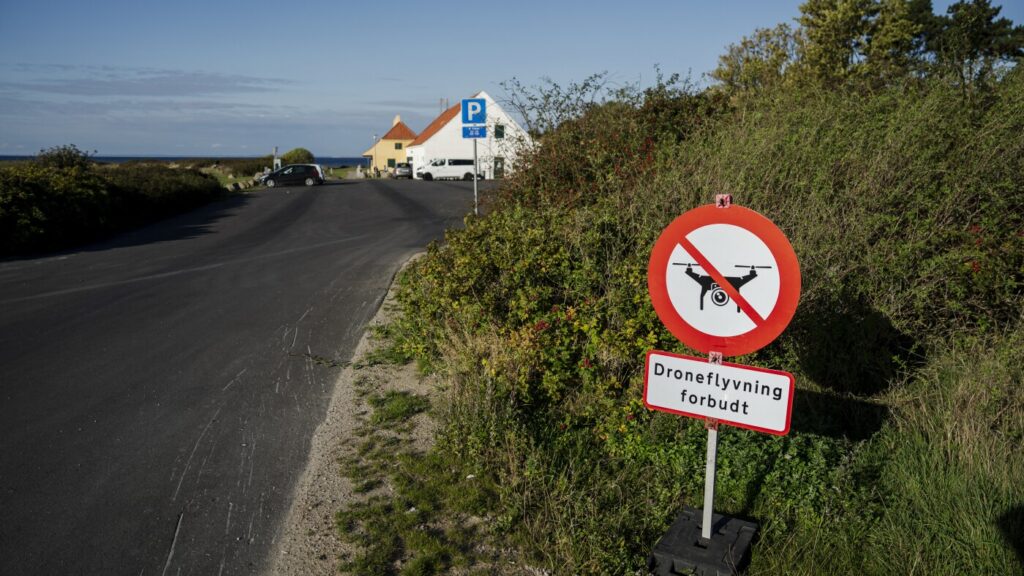A sign reading “drone flying prohibited” is pictured in Halsskov, West Zealand, Denmark. Denmark banned all civilian drone flights across the country as Copenhagen hosted a European summit, after mysterious drone sightings across the country began in September.
Mads Claus Rasmussen/Ritzau Scanpix/AFP via Getty Images
hide caption
toggle caption
Mads Claus Rasmussen/Ritzau Scanpix/AFP via Getty Images
COPENHAGEN, Denmark — Trine, a hotel receptionist in the Danish capital, has had trouble sleeping recently. She is too nervous about the unsettling noise of unidentified drones hovering in the night.
“I live very near the airport, so every night these helicopters and stuff are going around and around,” she said, making a whirring sound. “I really need to sleep.”
She’s not the only one whose nerves were frayed in Denmark.
Danish Prime Minister Mette Frederiksen says a “hybrid war” in Europe is underway, describing it as “the most difficult and dangerous situation since the end of the Second World War.”
The government has not officially pinpointed who staged the drone flights, but Prime Minister Frederiksen said: “There is only one country willing to threaten us and it is Russia, and therefore we need a very strong answer back.”
On Friday, the Danish Defence Intelligence Service said Russia is putting pressure on Denmark with “hybrid warfare,” which the agency defined as a combination of political, economic, information and military means “to undermine a state while remaining below the threshold of armed conflict.”
The United States and other NATO countries rushed military, law enforcement and technical resources to the Denmark this week to protect high-level meetings of European leaders in Copenhagen. Officials deemed the unidentified drones entering Denmark’s airspace a serious security risk.

Denmark’s prime minister, Mette Frederiksen (right), and Ukrainian President Volodymyr Zelenskyy attend a news conference at the European Political Community summit in Copenhagen, Denmark, on Thursday.
Nichlas Pollier/Bloomberg via Getty Images
hide caption
toggle caption
Nichlas Pollier/Bloomberg via Getty Images

After 3 1/2 years of Russia’s full-scale invasion of Ukraine, European countries like this one — Kyiv’s backers and military suppliers — are nervous the Kremlin could bring the conflict their way. Denmark, a NATO and European Union member with about 6 million people, is on high alert after the recent airspace incursions.
Russian President Vladimir Putin has denied any plans to invade NATO countries. Speaking on Thursday in Sochi, Putin accused Europe of “whipping up hysteria” about a “Russian threat.”
But this, Justice Minister Peter Hummelgaard warned on national television, is Denmark’s “new reality.”
Danes are very worried
“Everybody is talking about it,” Trine says about the drones, adding that her family is “very, very worried.”
NPR agreed not to use the last names of some of those interviewed in this story, because of the panic around this security issue.
Trine says being nervous made her take stock of her family’s emergency plans. “We prepped, we prepared,” she explained, checking their canned food supply, stocking up on water and reviewing their plan with other family members in case they have to evacuate their home in Copenhagen.

A sniper is seen on a roof as police secures the venue of a meeting of European Union leaders at Christiansborg Palace in Copenhagen, Denmark, on Wednesday.
Emil Nicolai Helms/Ritzau Scanpix/AFP via Getty Images
hide caption
toggle caption
Emil Nicolai Helms/Ritzau Scanpix/AFP via Getty Images
For Trine’s family — which includes a “fat bulldog that can’t run,” she notes — the plan would be to regroup at her father’s house “far, far out in the country.” She says, “It’s a big house,” with “room for everybody, me and my family, my brother and his family and my mom and everybody and the animals as well.”
She says she has heard from some friends who have more elaborate plans, that include even leaving Denmark if necessary.
Stocking up for an emergency
Like other Nordic governments, Denmark has long urged citizens to store enough supplies to survive a minimum of three days with no access to electricity, food or fresh water. Without the feeling of a direct threat, many people were complacent about actually doing that.

But that’s changed. Since the drones first appeared Sept. 22, the guidelines have been discussed widely in the media, along with attempts to avoid panic. Residents appeared to be taking them more seriously than before, with headlines about runs on canned fish and battery-powered radios.

Danish newspaper with headlines read “F-35 aircraft ready to strike” and “Easy prey for Putin,” on Sept. 27.
Teri Schultz for NPR
hide caption
toggle caption
Teri Schultz for NPR

At a home goods store in a Copenhagen suburb, sales associate Peter Sandell says 20 liter water containers are a hot item. “This morning we had this, this, this and this full,” he says, gesturing to a shoulder-high level of where the plastic jugs had been stacked hours earlier.
Nearby, the shelf for camping stoves is empty. Alejandra and Alexander, a couple who also want to be identified only by first names, snagged the last one. Alejandra’s arms are full of fuel canisters.
She says they hadn’t necessarily intended to buy one that day, but then they saw people walking out of the store with them and thought impulsively, “OK, let’s just buy [it] just in case.”
The couple explains they had stocked up on items like water before, but the drone incidents prompted them to hurry to complete the emergency list.
Make sure shelters are ready
Danish authorities have some catching up to do as well, says Jakob Hallgren, a former Swedish ambassador who is director of the Swedish Institute of International Affairs.
Sweden also went through a period like this shortly after the start of Russia’s full-scale war on Ukraine in 2022, Hallgren explains. But then the country reassessed the risk of being so close to the front line, and invested a lot in things like renovating and expanding its network of bomb shelters.
Hallgren advises that the Danish government do the same. “Living in Denmark you might have — just as maybe also in Sweden until a couple of years ago — kind of thought that you were shielded from these developments,” he says. “But this is obviously no longer the case. So if they haven’t, it’s really high time to make sure that those shelters are repaired and that there is proper information about where you can find them.”
Down with the drones
Many Danes are disappointed the government has not issued orders to shoot down the drones. Trine says she’d be happy to help, saying she joked to her policeman husband that she’d like to borrow one of his weapons.
“He looked at me, [like] ‘are you kidding?’ ” she laughs. “And then my daughter — she’s 20 — she said ‘aw, come on, Dad give her a bazooka.’ ”
Trine emphasizes that while she was kidding about taking things into her own hands, she definitely hopes the Danish government does shoot down the drones if they disrupt Danish skies again.

